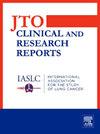肺腺癌中磷酸化Axl受体的脱落:双结构域免疫组织化学方法
IF 3.5
Q2 ONCOLOGY
引用次数: 0
摘要
axl是一种酪氨酸激酶受体,与上皮-间质转化(EMT)有关。本研究旨在探讨肺腺癌中磷酸化Axl (pAxl)细胞外结构域脱落的生物学意义,重点关注作为EMT潜在病理表征的通过空气间隙扩散(STAS)。方法本研究纳入202例肺腺癌切除术患者。采用双结构域免疫组化方法,分别对细胞外和细胞内结构域进行染色,将肿瘤分为脱落和非脱落pAxl组。以无复发概率(RFP)作为主要预后指标进行预后分析。此外,通过使用公共基因数据库,我们开发了“脱落pAxl评分”,以实验研究emt相关基因的相关性。结果pAxl脱落组预后明显差于非pAxl脱落组(5年RFP分别为54%和80%;p < 0.001)。这种pAxl脱落的预后分层在stas阳性患者中占主导地位(5年RFP分别为37%和75%,p < 0.001),但在stas阴性患者中不占主导地位(5年RFP分别为73%和84%,p = 0.3)。多因素分析显示,病理分期和pAxl脱落是复发的独立因素(危险比2.28 [1.24-4.91],p = 0.008)。脱落pAxl评分与建立的EMT特征评分密切相关(p < 0.001, R = 0.61)。结论pAxl脱落对肺腺癌的预后有影响,且与STAS相关的效应改变显著。已开发的pAxl脱落评分与EMT密切相关,为进一步研究这种现象在肺癌进展中的作用提供了基础知识。本文章由计算机程序翻译,如有差异,请以英文原文为准。
Shedding Phosphorylated Axl Receptor in Lung Adenocarcinoma: Dual-Domain Immunohistochemistry Approach
Introduction
Axl, a receptor tyrosine kinase, is linked to epithelial-mesenchymal transition (EMT). This study aimed to investigate the biologic implications of extracellular domain shedding of phosphorylated Axl (pAxl) in lung adenocarcinoma, focusing on spread through air spaces (STAS) as a potential pathologic representation of EMT.
Methods
This study included 202 patients with resected lung adenocarcinoma. A dual-domain immunohistochemistry approach using separate staining for the extracellular and intracellular domains was used to classify the tumors into shedding and nonshedding pAxl groups. Prognostic analysis was performed using recurrence-free probability (RFP) as the primary outcome. Furthermore, by using a public gene database, we developed the “shedding pAxl score” to experimentally investigate correlations with EMT-related genes.
Results
The shedding pAxl group exhibited significantly worse prognosis than the nonshedding pAxl group (5-year RFP, 54% and 80%, respectively; p < 0.001). This prognostic stratification of pAxl shedding was predominant in STAS-positive patients (5-year RFP, 37% and 75%, p < 0.001), but not in STAS-negative patients (5-year RFP, 73% and 84%, p = 0.3). Multivariate analysis revealed that pathologic stage and pAxl shedding were independent factors for recurrence (hazard ratio 2.28 [1.24–4.91], p = 0.008). The shedding pAxl score correlated strongly with the established EMT signature score (p < 0.001, R = 0.61).
Conclusions
Shedding pAxl has a prognostic impact on lung adenocarcinoma, with a significant effect modification related to STAS. The developed shedding pAxl score, strongly associated with EMT, provides foundational knowledge for further studies on this phenomenon in lung cancer progression.
求助全文
通过发布文献求助,成功后即可免费获取论文全文。
去求助
来源期刊

JTO Clinical and Research Reports
Medicine-Oncology
CiteScore
4.20
自引率
0.00%
发文量
145
审稿时长
19 weeks
 求助内容:
求助内容: 应助结果提醒方式:
应助结果提醒方式:


